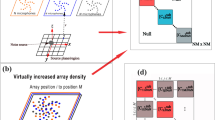Abstract
The classical least mean square (LMS) algorithm is a widely studied method for adaptive beamforming. It is well known for its lower computational complexity. However, fast and robust beamforming is not possible with the classical LMS method since it uses a constant step size. This nature hinders its applications in many advanced communication systems. Furthermore, this method degrades when the signal-to-noise ratio is rapidly changing. To circumvent these issues posed by the classical LMS method, two modified LMS beamformers are presented in this paper. We name these methods as M-LMS-1 and M-LMS-2. We present two new complex array weights to accelerate the rate of convergence. Computer simulations show that both methods present fast and robust beamforming. That is these algorithms have convergence improvement of about \(37.5 \%\) and \(50 \%\) over the standard LMS algorithm.







Similar content being viewed by others
Data Availability
Not applicable.
Code Availability
Not applicable.
References
Nawaz, S. J., Sharma, S. K., Wyne, S., Patwary, M. N., & Asaduzzaman, M. (2019). Quantum machine learning for 6G communication networks: State-of-the-art and vision for the future. IEEE Access, 7, 46317–46350.
Jones, M. A., & Wickert, M. A. (1995). Direct sequence spread spectrum using directionally constrained adaptive beamforming to null interference. IEEE Journal of Selection Areas Communication, 13, 71–79.
Slock, D. T. M. (1993). On the convergence behavior of the LMS and the normalized LMS algorithms. IEEE Transaction Signal Processing, 41, 2811–2825.
Rupp, M. (1993). The behavior of LMS and NLMS algorithms in the presence of spherically invariant processes. IEEE Transaction Signal Processing, 41, 1149–1160.
Taheri, O., & Vorobyov, S. A. (2014). Reweighted l1-norm penalized LMS for sparse channel estimation and its analysis. Elsevier Signal Processing, 104, 70–79.
Alagirisamy, M., & Singh, M. (2020). Efficient coherent direction-of- arrival estimation and realization using digital signal processor. IEEE Transactions on Antennas and Propagation, 68(9), 6675–6682.
He, J., Shu, T., Dakulagi, V., & Li, L. (2021). Simultaneous interference localization and array calibration for robust adaptive beamforming with partly calibrated arrays. IEEE Transactions on Aerospace and Electronic Systems, 57(5), 2850–2863.
Jin, H. E., & Dakulagi, V. (2022). 3-D near-field source localization using a spatially spread acoustic vector sensor. IEEE Transactions on Aerospace and Electronic Systems, 58(1), 180–188.
Dakulagi, V. (2021). a new approach to achieve a trade-off between direction-of-arrival estimation and computational complexity. IEEE Communications Letters, 25(4), 1183–1186.
He, J. (2021). Improved direction-of-arrival estimation and its implementation for modified symmetric sensor array. IEEE Sensors Journal, 21(4), 5213–5220.
Wang, S., Gao, C., Zhang, Q., Dakulagi, V., Zeng, H., Zheng, G., & Zong, B. (2020). Research and experiment of radar signal support vector clustering sorting based on feature extraction and feature selection. IEEE Access, 8, 93322–93334.
He, J., & Shu, T. (2022). A planar-like sensor array for efficient direction-of-arrival estimation. IEEE Sensors Letters, 6(9), 45213.
Dakulagi, V., & Alagirisamy, M. (2020). Adaptive beamformers for high-speed mobile communication. Wireless Personal Communications, 113(4), 1691–1707.
Dakulagi, V. (2021). Single snapshot 2D-DOA estimation in wireless location system. Springer Wireless Personal Communications, 117, 2327–2339.
Alagirisamy, M. (2019). Adaptive beamformers using 2D-novel ULA for cellular communication. Springer SN Application Science, 1, 1001.
Bhotto, M. Z. A., & Baji, I. V. (2015). Constant modulus blind adaptive beamforming based on unscented Kalman filtering. IEEE Signal Processing Letter, 22(4), 474–478.
Srar, J. A., Chung, K. S., & Mansour, A. (2010). Adaptive array beamforming using a combined LMS-LMS algorithm. IEEE Transactions on Antennas and Propagation, 58(11), 545–3557.
Shengkui, Z., Zhihong, M., & Suiyang, K. (2007). A fast variable step-size LMS algorithm with system identification. In 2007 2nd IEEE conference on industrial electronics and applications (pp. 2340-2345). IEEE.
Huang, H. C., & Lee, J. (2012). A new variable step-size NLMS algorithm and its performance analysis. IEEE Transactions on Signal Processing, 60(4), 2055–2060.
Aboulnasr, T., & Mayyas, K. (1997). A robust variable step-size LMS-type algorithm: Analysis and simulations. IEEE Transactions on Signal Processing, 45(3), 631–639.
Chen, R. Y., & Wang, C. L. (1990). On the optimum step size for the adaptive sign and LMS algorithms. IEEE Transaction Circuits System, 37, 836–840.
Godara, L. C. (1990). Improved LMS algorithm for adaptive beamforming. IEEE Transactions on Antennas and Propagation, 38(10), 1631–1635.
Funding
Funding is not applicable to this research work.
Author information
Authors and Affiliations
Corresponding author
Ethics declarations
Conflict of interest
The author declare that they have no conflict of interest.
Additional information
Publisher's Note
Springer Nature remains neutral with regard to jurisdictional claims in published maps and institutional affiliations.
Rights and permissions
Springer Nature or its licensor (e.g. a society or other partner) holds exclusive rights to this article under a publishing agreement with the author(s) or other rightsholder(s); author self-archiving of the accepted manuscript version of this article is solely governed by the terms of such publishing agreement and applicable law.
About this article
Cite this article
Dakulagi, V. Improved Adaptive Beamforming Algorithms for Wireless Systems. Wireless Pers Commun 130, 625–633 (2023). https://doi.org/10.1007/s11277-023-10302-w
Accepted:
Published:
Issue Date:
DOI: https://doi.org/10.1007/s11277-023-10302-w




